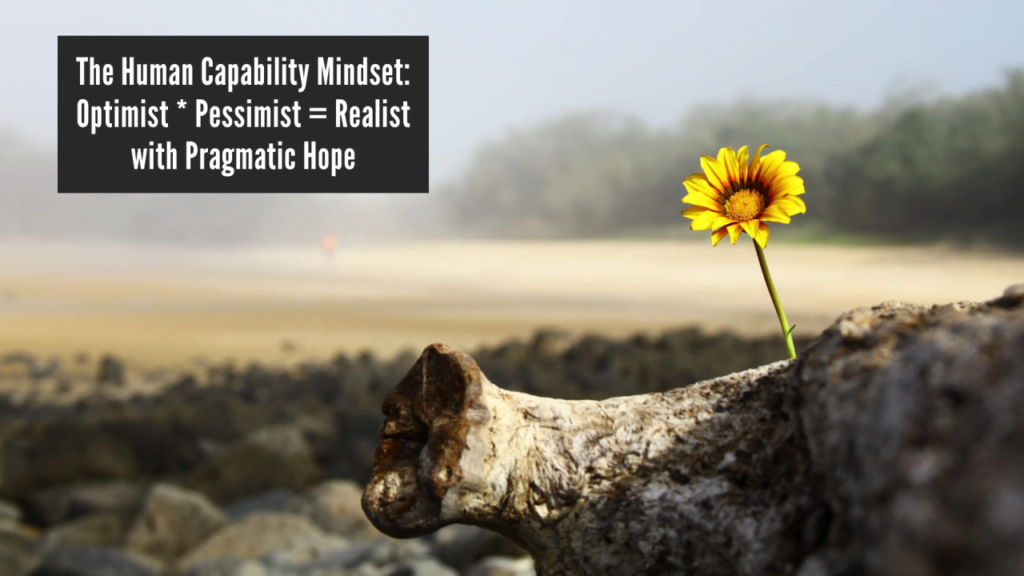The Human Capability Mindset: Optimist * Pessimist = Realist with Pragmatic Hope

I saw buds on our bushes today. Spring often represents renewal. This year, the Easter holiday and Ramadan/EID overlap, each symbolizing commitment to growth. This season leads me to reflect on how to create a mindset of renewal by understanding both pessimism and optimism, and how these attitudes show up in human capability (talent + leadership + organization + HR).
Often pessimism versus optimism is a trade-off. Pessimists focus on what is wrong; optimists focus on what is right. Pessimists act out of fear — optimists hope. Pessimists learn by improving — optimists by inventing. Pessimists often feel out of control — optimists take control. Pessimists doubt and question — optimists exude confidence through answers. Pessimists move cautiously — optimists advance quickly.
Denigrating pessimists and praising optimists is easy to do. However, I believe either extreme poses a liability. Extreme pessimists may not create and may become caustic skeptics; extreme optimists may not accept reality and become naïve idealists. Let me suggest that navigating the paradox of pessimism versus optimism enables realism (see figure 1). Realism means that failure is an opportunity to learn and move forward through pragmatic hope. The glass is both half empty and half full, so figure out what to do with what is there—drink it or fill it.
In this spring and holiday season, such realism prevails and embodies the spirit of the season of growth: out of self discipline comes other-service; out of reflection comes insight; out of devotion to others comes personal progress; out of personal sacrifice comes spiritual growth; out of death comes life.

How to move towards realism?
Everyone has a predisposition towards pessimism or optimism (a place on figure 1). Let me suggest four principles that instill more realism at work through pragmatic hope.
1. See the world as it is: both good and bad.
We easily bring an all or nothing mindset to work where a product, service, or employee is either good or bad. Realism relishes nuances where both positive and negative exist simultaneously. Realists often rely on data as a foundation for learning. When successful, they explore “why”; and when not successful, they delve into “why not” so that they can improve from either result. They surround themselves with others not like themselves so that they can appreciate other points of view. They hope that the good will emerge even from the bad.
2. Move forward but bring the past with you.
Realists frame change as both an evolution of the past and a creation of the future. They honor previous work and the context in which it occurred. They have future aspirations that exceed resources to stretch and define what can be. They experiment with ideas and actions to create a mindset of curiosity to try new things that might work. They hope that the aspirational future can be realized with daily actions.
3. Relate to others as they are, not as you would like them to become.
Realists focus not only on their personal agenda but appreciate others’ agenda, and they understand how their agenda impacts others. I often observe leaders (and speakers) sharing “what they know” more than how “what they know” will help others grow. Realists listen to discover someone else’s biases, wants, and needs before making recommendations, which helps turn one’s ideas into someone else’s actions. When realists disagree, they seek the most benevolent explanation possible for the disagreement to find common ground. When realists are frustrated with someone, they try to serve to build a positive relationship. They hope for the best in people, but accept people as they are.
4. Express gratitude and foster progress.
Realists find something to appreciate about what has been done. When things go well, they celebrate success; when things do not go well, they candidly face the situation with honest conversation. Realists want to ensure that those who leave an interaction feel better about themselves. They hope by being grateful for what is while being remorseful for what is not.
These four principles (and there could be others) apply to many settings—personal hobbies, family patterns, friends and neighbors, and work. At work, these principles become embedded through human capability efforts built on pragmatic hope.
How does realism get embedded through human capability actions?
We have classified the array of human capability initiatives into four domains: talent, leadership, organization, and HR. The initiatives in each of these four domains advance through realism.
Talent: When employees are realistic and treated with realism, they are optimistic about what they can become and contribute but also aware of what is within their ability. They focus attention on contributions that help them create value for others.
Leadership: Realistic leaders calmly and confidently help others become more effective by acknowledging their strengths and weaknesses. They focus attention on helping others improve.
Organization: Realistic organizations grow with both dramatic innovation and daily implementation. They focus attention on both strategic direction and disciplined action.
Human Resources: Realistic HR departments design and deliver value to all stakeholders. They focus less on HR and more on the value their work creates for others.
Figure 2 offers a simple assessment of the evidence of realism in each of the four domains.

My pragmatic hope is that the renewal of spring and celebration of religious holidays leads to realism that enables progress.
So what is your personal predisposition: towards optimism or pessimism? How can you individually learn to become realistic to gain the benefits of both? How can you institutionalize realism through your human capability initiatives?
Dave Ulrich is the Rensis Likert Professor at the Ross School of Business, University of Michigan, and a partner at The RBL Group, a consulting firm focused on helping organizations and leaders deliver value.
Originally published in LinkedIn






Responses